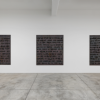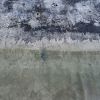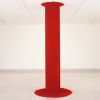Fort Mason Center for Arts & Culture (FMCAC) is pleased to present Sophie Calle’s Missing, a large-scale exhibition curated by Ars Citizen of the internationally acclaimed French artist. Featuring five of Calle’s most prominent projects, the exhibition is her most extensive to date in the United States. Conceived as a journey, Missing gathers five of Sophie Calle’s major projects – itinerant since their creation – into a site-responsive presentation across the historic and scenic FMCAC campus on the San Francisco waterfront. The corpus offers an overview of Calle’s art since the 1980s, and includes her iconic projects spanning the last decade: Take Care of Yourself, Rachel Monique and Voir la mer. Unveiling through a narrative of intimate stories, both personal and collective, Missing emphasizes the analogy of mother and sea (“mère” and “mer” in French), while proposing a reflection on the universal concepts of disappearance, loss and absence, central in the artist’s work and exploration.
Rachel Monique (2007)—Installed in the former U.S. Army Chapel, the poignant and poetic multimedia installation features the personality and final moments of Sophie Calle’s mother.
True Stories (1988)—In the vintage General’s Residence, True Stories presents a selection from Calle’s growing collection of personal belongings and autobiographical anecdotes crystallizing key moments in her life.
Take Care of Yourself (2007)—Located in Gallery 308, Take Care of Yourself documents 107 women interpreting a break-up letter Calle received from an ex-lover. This body of work was originally created for the French Pavilion of the 2007 Venice Biennale.
Voir la mer (2011)—In the Firehouse, which offers a stunning view of the San Francisco Bay, viewers will experience the film installation featuring residents of Istanbul, Turkey, seeing the ocean for the first time.
Also displayed in the Firehouse, The Last Image (2010) is a series of photographs and texts that portrays the last visual memory of blind people.
“Sophie Calle Missing” will be open and free to the public from June 29, 2017 through August 20, 2017.
Ars Citizen is curating parallel programs in partnership with leading San Francisco Bay Area cultural and educational institutions. They will include a conversation with Calle at FMCAC; a screening of Calle’s film and video works at UC Berkeley Art Museum and Pacific Film Archive (BAMPFA) with a conversation between the artist and Lawrence Rinder, Director of BAMPFA; a presentation and book signing with Calle at City Lights Bookstore; and a Sophie Calle film anthology at San Francisco’s Roxie Theater. On the occasion of the event, Fraenkel Gallery will also present a special exhibition by Sophie Calle at FraenkelLAB. Additional events and details to come.Continue Reading..


















